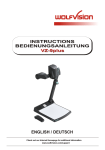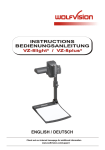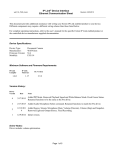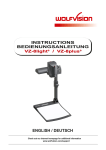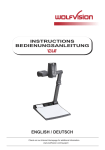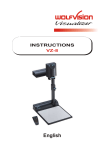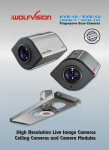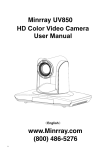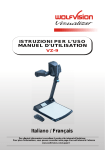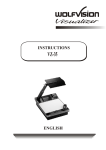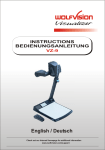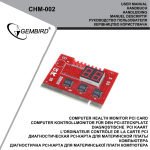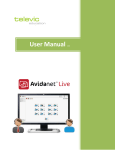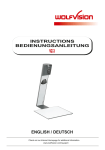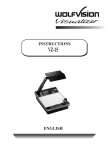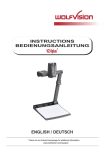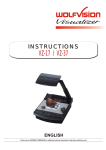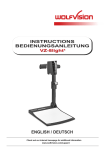Download Manual VZ9plus English_Deutsch.cdr
Transcript
R INSTRUCTIONS BEDIENUNGSANLEITUNG VZ-9plus ENGLISH / DEUTSCH Check out our Internet Homepage for additional information www.wolfvision.com/support Precautions ENGLISH WARNING! Risk of electric shock Dangerous voltage inside Please observe the following: USE THIS MACHINE ONLY WITH THE CORRECT VOLTAGE AS SHOWN ON THE TYPE LABEL ! DO NOT EXPOSE THE UNIT TO EXTREME HEAT OR MOISTURE ! PROTECT THE UNIT FROM EXCESSIVE SHOCKS ! Make sure that sufficient air circulation for cooling the unit is possible! If there is any abnormality (abnormal noise, smell, smoke etc.) disconnect the unit from mains immediately and contact your Visualizer dealer! Do not use a damaged power cord / power supply. This may cause short circuits or electrical shocks! To prevent danger, do not modify the Visualizer or operate without the cover panel firmly in place! Do not expose the Visualizer to water, metallic objects or any flammable material. Avoid installing the Visualizer in environments where there is radiation. Avoid installing the Visualizer in locations exposed to strong magnetic fields or electrical currents. This could cause monitor image distortion or damage to the CCD camera. Do not pull the plug from the power socket with wet hands! If the Visualizer is not used for a long time, disconnect it from mains! The external power supply has to be approved by CSA or UL in accordance to CSA 22.2-60950 or UL 1950. The outputs have to be LPS (limited power source) rated! Precautions for laser pointer: AVOID EXPOSURE Laser radiation is emitted from this aperture. LASER RADIATION - DO NOT STARE INTO BEAM 650nm, P<1mW CLASS II LASER PRODUCT LASER RADIATION DO NOT STARE INTO BEAM CLASS 2 LASER PRODUCT OUTPUT POWER <1mW WAVELENGTH 650nm EN 60825-1 March 1997 1 Laser information FDA accession number: 9912688-00 This device complies with 21 CFR 1040.10 and 1040.11 Approval Marks on the unit: C Tested to complywith FCC standards for home or office use US L I ST E D 9902476 FCC information: This device complies with part 15 of the FCC rules. Operation is subject to the following two conditions: (1) this device may not cause harmful interference, and (2) this device must accept any interference received, including interference that may cause undesired operation. Note: This equipment has been tested and found to comply with the limits for a class B digital device, pursuant to part 15 of the FCC rules. Information to user: The user manual or instruction manual for an intentional or unintentional radiator shall caution the user that changes or modifications not expressly approved by the party responsible for compliance could void the user's authority to operate the equipment. This product is built according to Directive EMC and to Directive electrical equipment. Inspections, tests and evaluation are according to UL 60950. CSA 22.22-60950 Inspections, tests and evaluation are according to the CB-Scheme Inspections, tests and evaluation are according to the PCT-Scheme Worldwide Patents EU 1 483 529 RU 2279602 US 7,104,512 TW I 247964 KR 0576806 RU 2265284 US 7,035,011 TW I 226969 DE 202 03 785.1 AT-U 7841 FR 03 02886 JP 3 096 342 and others Copyright Information Copyright © by WolfVision. All rights reserved. WolfVision, Wofu Vision and are registered trademarks of WolfVision Holding AG, Austria. No part of this document may be copied, reproduced, or transmitted by any means, without prior written permission from WolfVision. Except documentation kept by the purchaser for backup purposes. In the interest of continuing product improvement, WolfVision reserves the right to change product specifications without notice. Information in this document may change without notice. Disclaimer: WolfVision shall not be liable for technical or editorial errors or omissions. The units are "MADE IN EU/AUSTRIA” Printed in Austria, October 2007 2 #5 #3 #8 #9 #12 #6 #15 #1 #14 #13 #5 #2 #7 #10 #4 #16 #11 #11 #1 Connectors (on the back as shown below) #2 Power and light on/off key (see page 4) #3 Camera keys, zoom wheel (see page 4) #4 IR-remote control (see page 5) #5 IR-receiver (2 receivers on camera head and 1 on base) #6 Pull pad to lift the arm up/down (see page 6) #7 Power indication LED #8 Camera head (see page 4, 6 and 7) #9 Light (see page 7 and 8) #10 Working surface (see page 6) #11 Pad to rotate the VZ-9plus (see page 7) #12 Close up lens for camera (see page 7) #13 Preview monitor (see page 6) #14 Light field for slides (see page 6) #15 Slot for Kensington lock® (see page 10) #16 Alternative Antitheft security (found underneath the unit as shown on page 10) Connectors (#1) RS 232 #17 #17 #18 #19 #20 #21 #22 #23 #24 EXTERN IN #18 DVI RGB #19 #20 RS-232 serial control input RS232 (see page 12) External input for computers (see page 10) DVI output (see page 11 and 14) RGB output (see page 11) USB-port (see page 12) LAN-port (see page 12) Power connection 12V DC-output for lightbox (see page 14) 3 USB LAN POWER LB #21 #22 #23#24 Keys on the Visualizer Base #25 LIGHT key Switches the top light on and off. If a separate optional WolfVision light box is connected, the LIGHT switch toggles between top light, light field for slides, external WolfVision light box and light off. The LIGHT key also works as ONE PUSH WHITE BALANCE key if pressed for 2 seconds (see page 8). #26 POWER key Switches the unit on and off. When switching the unit on the Visualizer automatically runs power-on preset. #25 #26 LIGHT WHITE POWER Camera Head One of the great features of WolfVision's Portable Visualizers is that only the most necessary keys are on the unit itself. Therefore anyone can use it without instructions. For more experienced users there are some additional functions on the remote control of the Visualizer. Nearly all functions on the remote control can also be controlled through the keys on the camera head: < > #27 ZOOM WHEEL / menu: scroll wheel Turn the wheel down to zoom in (TELE), and #27 up to zoom out (WIDE). The more you turn the ZOOM WHEEL, the faster the zooming works. ZOOM Using the ZOOM keys (wheel) also #28 switches auto iris on again. FOCUS When on-screen menu is activated, it works as scroll #29 wheel for navigating through the on-screen menu. #30 #28 Manual FOCUS keys / menu: select keys #31 When the Manual FOCUS keys are pressed the Visualizer switches off the autofocus function. Using the AF-key switches the autofocus function on again. When the on-screen menu is activated, it functions as select keys. #29 AUTO FOCUS (AF) key / menu: help key Switches the auto focus on and off. The AF light indicates if the AF is switched on. When on-screen menu is activated, it functions as Help key. Pressing this key for 2 seconds resets the selected menu item. #30 FREEZE key / PRESET 1 key Freezes the current image. The FREEZE light indicates if the FREEZE-mode is activated. By pressing the FREEZE key for 2 seconds, preset 1 will be recalled. (see page 9). #31 EXT/INT key / menu key Switches between Visualizer image and external input (for more details - see page 10). The EXT IN light indicates that a signal from the external input is shown. Pressing this key for 1 second activates the on-screen menu (see page 13). MAN AUTO FREEZE EXT / INT 4 < > HELP PRESET 1 MENU Infrared Remote Control A LASER #32 ZOOM keys #32 #32 The ZOOM keys work like the ZOOM WHEEL on the camera head of the Visualizer. Using the ZOOM keys (wheel) also switches auto iris on again. TELE WIDE #33 #33 LASER POINTER key Important: Do not stare directly into the laser beam. PRESETS #34 This is hazardous for your eyes! 3 1 2 #34 PRESET keys (programmable settings) IMAGE TURN AF FOCUS #37 For storing a preset, press one of the PRESET keys A #35 #36 for more than 2 seconds. For recalling a preset, EXT / INT ALL IRIS press the PRESET key quickly (see page 8). #40 #38 #39 #35 IMAGE TURN mode key MEMORY For picking up vertical (portrait) pages with higher resolution (see page 9). 3 1 2 #41 #36 AUTO FOCUS (AF) key HELP 5 6 4 Switches the auto focus on and off. #37 Manual FOCUS keys 7 8 9 When the FOCUS keys are pressed the Visualizer #43 #42 switches off the autofocus function. The next time MENU POWER the AF-key is pressed, autofocus is switched on again. #45 #38 EXT/INT key #44 This switches between Visualizer image and external input (see page 10). #39 ALL key For displaying all 9 pictures of the memory as split image (see page 9). #40 Manual IRIS keys (brightness adjustment) When the IRIS keys are pressed, the Visualizer switches off the Auto iris function. The next time the ZOOM keys/wheel are used the auto iris is switched on again. For specialists: The overall iris level can be changed in the on-screen menu (see page 13). #41 SELECT keys (double function of MEMORY keys 2, 4, 6 and 8) For navigating through the on-screen menu (see page 13). #42 HELP/RESET key for on-screen menu (double function of MEMORY key 5) While you are in the on-screen menu you can activate the on-screen help by pressing the number 5 key. Pressing this key for 2 seconds resets the selected menu item (see page13). #43 MEMORY keys 1 - 9 For saving and recalling pictures (see page 9). #44 MENU key Pressing this key for 1 second activates the on-screen menu (see page 13). #45 POWER key Pressing this key switches the unit on and off. When switching on the unit, the Visualizer runs the power-on preset. 5 Setting Up the Visualizer 1. Connect the power pack to the power-input (#23). 2. Connect your display device (projector, monitor, video conferencing unit etc.) to the appropriate output of the Visualizer (#19, #20, #21 or #22). IMPORTANT: For choosing the right output please read the detailed description on page 11! 3. Pull the arm upwards using the pull pad (#6). Camera head and light automatically move into the working position. The VZ-9plus is switched on automatically. Power-on preset: The power-on preset is automatically activated when switching on the unit. The settings are: zoom size: approx. 20 x 15 cm (DIN A5), autofocus: on, auto iris: on. Working Surface The working surface of the Visualizer (#10) has a special crystalline white color, which is especially designed for perfect reproduction of transparencies. In the following cases, an optional lightbox is recommended: - If the transparency is very dark - If the transparency is very wavy and causes reflections - If the room light causes reflections on a transparency Built-in LCD Monitor Monitor The built-in LCD monitor makes positioning of objects very easy and eliminates the need for an additional control monitor. This monitor can show different signals, like “external in”-image, stored-image or life-image (selectable in the on-screen menu see page 13). The on-screen menu is also visible on this LCD monitor. The brightness of the LCD-monitor is adjustable in the on-screen menu. Light Field For Slides Slide Place the slide onto the built-in light field, turn the camera head until the slide is in the middle of the recorded image and switch it on using the LIGHT key (#25). The camera zooms the slide automatically in. The camera automatically focuses on the slide. 6 Shooting Area on the Working Surface Eliminating reflections In order to eliminate reflections (on high gloss photographs etc.) just turn the light upwards or downwards slightly. It is also possible to move the document and rotate the camera head to the center of the desired pick-up area to eliminate reflections. Please note that reflections can also be caused by general room lighting conditions. Shooting Area Outside of the Working Surface to infinity Close-up adaptor lens For shooting an object outside of the working surface, the close up lens (#12) has to be removed. In this case just hinge the lens away from the camera head. It is impossible to remove the lens completely from the unit and therefore it can not get lost. When using the Visualizer to again record on the working surface, put the close up lens back to its original position. Turning the light / flexible viewing angle In order to enable recordings with illumination outside of the working surface, the light of the Visualizer can be turned vertically. To record at a lower viewing angle than the normal working position, just fold the arm of the Visualizer as much as required, turn the camera head and the light to pick up the desired object. Image Flip By turning the camera head to record in front of the Visualizer, the image will automatically be turned 180 degrees (”image flip”). This feature is very useful for recording the face of the presenter or objects hanging on the wall behind the unit. Turntable The turntable of the Visualizer allows for horizontal pan shots when using the Visualizer as a camera to record outside of the working surface. It is also very useful when two people, sitting on the same table, alternately work with the unit. When the unit is delivered, the turntable is unlocked (see page 10 to lock the turn table). 7 Autofocus Please note that objects with very low contrast (like blank sheet of paper) are difficult to focus. If the autofocus does not work just move the object slightly. For special applications the autofocus can also be switched off using the on/off switch (#29 or #36). The autofocus is also switched off when the manual FOCUS keys (#28 or #37) are used. Digital Zoom Please note that the Visualizer has an optical 12x zoom. The digital 4x zoom increases the overall zoom range to a 48x zoom. The smallest pickup size on the working surface without digital zoom is 23 x 31mm (0.91" x 1.22"). When you zoom in further the digital zoom is automatically activated and the smallest pickup size is 6 x 8mm (0.24" x 0.31"). However please be aware that when the digital zoom is used, the resolution of the picture is not as good as before. The default setting displays a message on-screen when you are in the digital zoom mode. Still pictures in the memory can also be digitally zoomed. . You can change the behavior of the Visualizer in the digital zoom mode in the on-screen menu (see page 13). White Balance Correct white balance adjustment is important for exact color reproduction. "Auto Tracking" is the default white balance setting when the Visualizer is shipped. This means that the white balance is continuously adjusted automatically. For an exact white balance, 10% of the recorded image should be white (measurement area is in the center of the image). For a precisely fixed white balance adjustment use the "One Push" white balance. This can be done by completely zooming in on a white sheet of paper on the working surface and pressing the LIGHT key (#25) for 2 seconds. When the white balance is stored, an onscreen message appears. Setting a "One Push" white balance switches off the "Auto Tracking" mode (when the unit is switched off and on again the "Auto Tracking" mode will be reactivated). When the lighting conditions change (e.g. light box, sunlight or different room light) the white balance should be readjusted! For specialists: The Visualizer can be switched between "Auto Tracking", "One Push" and "Manual" white balance mode in the on-screen menu (see page 13) If you work with negative transparencies and a light box, use a blank (black in the image) piece of the negative film for white balance adjustment! The “One Push” white balance will be separately adjusted and stored for top light and external light box (if available). Preset Function The Visualizer offers the possibility to store the current settings as a preset and recall them by just pressing the respective PRESET key (#34) on the remote control. The Preset 1 can be recalled by pressing the FREEZE key (#30) on the camera head for 2 seconds. For storing a preset: adjust any function as required and then press any one of the PRESET keys on the remote control for 2 seconds or more. An on-screen message will inform you when the preset is stored. The presets can also be stored in the on-screen menu. When presets are stored as mentioned above, all current settings such as zoom, focus, iris etc. are stored. Contrary to this, a user also has the opportunity to assign only specific functions such as "Negative", "Negative/Blue", "Black/White" etc. to a PRESET key in the on-screen menu of the Visualizer (see page 13). 8 Image Memory for 9 images You can store 9 images and recall them by just pressing one of the numerical keys (#43) on the infrared remote control: Press one of the MEMORY keys (#43) for 2 seconds or more Recalling an image: Press one of the MEMORY keys (#43) quickly Storing an image: Split image of 9 picture memory By pressing the "All" key (#39) a split image with all 9 pictures of the memory can be displayed. When pressing the ALL key (#39) for 4 seconds, a menu appears on the screen asking if you would like to erase all stored pictures (black picture) or if you would like to fill the memory with “snapshots”. When choosing “snapshot” the Visualizer stores a new image every second until all 9 memory locations are full. The Visualizer is equipped with a memory backup battery. If the power supply has been disconnected any pictures in the memory will be stored for up to 4 weeks. The functional settings of memory erasing can be changed in the on-screen menu. Image Turn Mode (for higher resolution) Output picture: Working surface: Normal mode: A A Only 50% of the pixels are used to pick up the document A Image turn mode: 90% of the pixels are used to pick up the document A Picking up a complete vertical (portrait) document or A4 page has always been a critical issue for a Visualizer because the image was always picked up in a horizontal (landscape) format. The camera could only use 50% of its pixels to pick up a vertical (portrait) page. WolfVision's "Image turn" mode solves this problem. Just place your document (or other vertical object) on the working surface horizontally and zoom in on it completely, so that approx. 90% of the pixels of the built-in camera are used to pick up the document, then press the IMAGE TURN key (#35). The Visualizer turns the picture electronically 90º and outputs it correctly with a much higher resolution than in normal mode. The left and right margins will be black. Text Enhancement For improving the readability of text, sketches or x-rays, the text mode can be activated by pressing the programmed PRESET-key (#34). This mode enhances the contrast of the picture. Please note that the colors are now darker than usual. To switch off the text enhancement mode, press the programmed PRESET-key again. When the text enhancement mode is in use, the message "TEXT" is permanently displayed on the output. This should remind the user to switch off the text mode when it is no longer required. It should also prevent users trying to correct dark colors by opening the iris, resulting in a poorly adjusted picture. 9 External Input - EXT/INT A computer can be connected to the External RGB input (#18) of the Visualizer. By pressing the EXT/INT-key (#31 or #38) you can switch between the Visualizer image and the image of the external input to be displayed to the audience. The extern mode can also be used for only one output. The behavior can be changed in the on-screen menu (see page 13). The VZ-9plus has a built-in A/D-converter in order to digitize the analog RGB signal from the computer and output it on all outputs in the selected signal format (allowed input signals: from VGA to SXGA/75Hz). Anti-theft device 1: T-bar lock The Visualizer can be fixed with a security cable T-bar lock (Kensington® Lock), so that it can not be stolen. Follow the instructions from the cable lock manual. slot for lock Anti-theft device 2: table lock bolt washer 8.4/16x1.6 screw M8x35 or screw M8x50 table (sectional view) turntable 168mm (6.6”) 160mm (6.3”) attachment area 2 The Visualizer can also be fixed onto a table with the supplied table lock bolt in order to minimize the risk of theft. Please note that the usable depth of thread is 8mm, do not screw in more than this. Supplied accessories: 1x Socket head cap wrench 5mm (E 27400) 1x Allen screw driver 2,5mm (E 27410) 1x Screw M8x35 (D 25120) 1x Screw M8x50 (D 25130) 2x Washer 8.4/16x1.6 (D 13030) 1x Assembly instructions VZ 9plus (E 27300) Lock Turntable Remove the screw from the hole position 2 and insert it into the specific hole position 1 (the turntable might have to be turned until the thread is visible). Use supplied Allen screw driver (2,5mm). 1 10 Choosing the Correct Output Mode The DVI and RGB output (#19 and #20) can output signals in the following formats: - VGA - SVGA - XGA - SXGA- (4:3 - 640x480 pixels) at 60Hz (4:3 - 800x600 pixels) at 60Hz, 75Hz or 85Hz (4:3 - 1024x768 pixels) at 60Hz, 75Hz or 85Hz (4:3 - 1280x960 pixels) at 60Hz or 85Hz - native image - SXGA (5:4 - 1280x1024 pixels) at 60Hz or 75Hz - SXGA+ (4:3 - 1400x1050 pixels) at 60Hz or 75Hz - UXGA (4:3 - 1600x1200 pixels) at 60Hz - XGA 16:9 (special format for non-HDTV capable 16:9-Plasma displays) at 60Hz - WXGA/60 (16:9 Widescreen - 1360x768 pixels) at 60Hz - WSXGA+/60 (16:10 Widescreen - 1680x1050 pixels) at 60Hz - 720p/50 (16:9 Widescreen HD/HDTV - 1280x720 pixels) at 50Hz - native image - 720p/60 (16:9 Widescreen HD/HDTV - 1280x720 pixels) at 60Hz - native image - 1080p/50 (16:9 Widescreen HD/HDTV - 1920x1080 pixels) at 50Hz - 1080p/60 (16:9 Widescreen HD/HDTV - 1920x1080 pixels) at 60Hz The "Auto resolution" function is activated by default. In this mode the Visualizer continuously checks which devices are connected to the RGB (#20) and DVI output (#19) and automatically sets the optimal output mode for each connected device separately. Please note that the Visualizer can not check the possible resolution, if the connected units or the cables* are not "Plug and Play" compatible. If the Visualizer can not detect the resolution of the connected device, the output is set to the default of XGA (1024x768)/60Hz. (*Cables with plug and play compatibility must have a 15-pin plug on both ends with all pins connected, pin 9 is not used). If you can not use the "Auto resolution" function, you can select the output mode manually in the on-screen menu of the Visualizer (see page 13). In order to achieve the best picture quality you must set the outputs of the Visualizer to match the native resolution of your display unit (e.g. LCD or DLP projector or monitor). Important: What matters is the native resolution of the projector or monitor, not the maximum resolution that it can display (in compressed mode). The native resolution is the actual number of pixels of the built-in LCD display or DLP chip of a projector or monitor. Most LCD or DLP projectors can also display higher resolutions than their native resolution, but only in compressed mode and with inferior picture quality. Do NOT set the output of the Visualizer to a higher standard than the native resolution of your display unit! If you output the Visualizer image on a CRT monitor or CRT projector, use an output mode with 75 or 85Hz, because 60Hz may show a slight image flickering. For LCD/DLP projectors or monitors and video conferencing units 60Hz is the best choice. If you are unsure what the best mode is, read the user manual of the connected units. Do not set a higher refresh rate than your monitor or projector can display, otherwise the monitor or projector can be damaged! Follow the instructions in the user manual of the connected units. Please note, if 4:3 and 16:9 or 16:10 resolutions are used simultaneously, the 4:3 display shows black bars on top and bottom. This is necessary to ensure that all displays show the same image content. 11 Ethernet / LAN Port 10BASE-T/100Base-TX The LAN connection can be used for controlling the Visualizer over a computer network. Image transfers, firmware updates, displaying status information and e-mail notifications are possible. The following protocols are supported: TCP/IP, ICMP and ARP. Supported internet browsers are: Internet Explorer, Netscape Navigator and Mozilla/Firefox. By default, DHCP is activated to receive all settings automatically. Image transfer resolution: still image: 1280x960 (or 640x480), live image: 256x192 Please check the separate ETHERNET / LAN description on our internet homepage at: www.wolfvision.com/support (or on the supplied CD-Rom). USB Port The USB output of the Visualizer can be used to transfer images from a Visualizer to a computer and save them in JPG, TIF or BMP format. This way, Visualizers can also be used as scanners for 3-dimensional objects. WolfVision Visualizers are equipped with a fast USB 2.0 port. This allows uploading images onto a PC in a fraction of a second. Connecting slower computers with the older USB 1.1 standard is also no problem. It still takes only a small fraction of the time a desktop scanner requires to scan an image. WolfVision's USB software works under Windows 98, ME, 2000, XP and Apple Macintosh and is fully Twain compatible. This is important when using the Visualizer in connection with popular graphic programs such as Photoshop, or for connecting them to Interactive Whiteboards (Smart Boards). The fast USB 2.0 port can also output live motion. The WolfVision USB software can store AVI files and includes a video capture driver. You can view and save the live image from the Visualizer on your computer in almost every modern video editing software. Please download the latest version of the WolfVision USB-software from: www.wolfvision.com/support. RS-232, Serial Control Input The serial port can be used to control the Visualizer through an external device, such as a room control system that are used to integrate conference rooms. 1 2 3 4 5 Pins: Baud Rate: 6 7 8 9 9-pin D-Sub connector on unit; male (front side) 2: RX, 3: TX, 5: GND 9200, 19200, 38400, 57600 or 115200 (selectable) databits: 8, stopbit: 1, parity: no The baud rate can be changed in the on-screen extra menu (see page 13). Please note that decimal codes (=ASCII codes or Hex codes) must be sent as one single byte (e.g. 199 and not: 1 + 1 + 9) ! The complete serial protocol can be found on our internet website under: www.wolfvision.com/support 12 The following chapter is for experienced users only: ON-SCREEN MENU / ON-SCREEN HELP For regular use of the WolfVision Visualizer, it is not necessary to go into the Visualizer's menu and change settings. Inexperienced users should not make any adjustments here. To enter the on-screen menu press the MENU-key (#31 or #44) for one second. Settings of the Visualizer's basic functions and the built-in camera can be made here using the 4 SELECT-keys on the remote control (the numerical keys with red arrows - #41) or the ZOOM-wheel (#27) and FOCUS-keys (#28) on the camera head. Please note that some basic settings in the menu can only be changed if you set the menu item "Format protect" to "OFF" first. If more information on a function in the on-screen menu is required, set the cursor in the respective line and press the HELP key (#42, this is a dual function of the Number 5 key) or the AF-key (#29) on the camera head. A detailed description of this function appears on the screen. If you want to reset the selected item to the default setting, press the HELP-key (#42 or #29) for 2 seconds. By pressing the MENU-key for 4 seconds the Extra Menu appears. In the Extra Menu, settings like baud rate can be changed. The functions of the on-screen menu are not described in detail in this user manual since the HELP menu is an integrated part of the Visualizer's software (firmware). The information you see on your screen always belongs to the current Visualizer firmware. Switching To Negative, Negative/Blue and Black/White The output image of the Visualizers can be switched from positive to negative in the onscreen menu. In addition, the background of a negative image can be switched to blue for better readability of text. You can also switch between color or black and white in the onscreen menu. TIP: If you often switch to negative, negative/blue or black/white images, you can assign this function to one of the Preset keys (see page 8) in the on-screen menu. Changing the Standard Contrast (Color) Settings If the picture or the colors on your screen appear to be too dark, you can lower the overall contrast of the picture in the "Color Settings" menu of the on-screen menu. The settings can be made separately for the normal mode and the text mode. Auto Power-off In the "Power Control" settings of the on-screen menu you can select that the Visualizer will be automatically switched off after a certain amount time. Reset On-Sreen Menu Settings All settings in the on-screen menu can be set back to the factory defaults. "Reset" is a category in the on-screen menu. In case you can not read the menu on the screen you can also set the unit back to the factory defaults by simultaneously pressing both FOCUS-keys on the camera head (#28) and the Number 4-key (back-arrow, #41) on the remote control. If you only want to reset the item that is currently selected to the default setting, press the HELP-key for 2 seconds! 13 Firmware Upgrades The software (firmware) of your Visualizer (including the on-screen HELP) can easily be upgraded to the latest version. The firmware update can be done via USB, Ethernet (LAN) or RS232. Firmware update files can be downloaded for free at www.wolfvision.com/support. Updates via USB can be made with the WolfVision USB Software, updates via Ethernet/LAN require the WolfVision Ethernet Software and updates via RS232 can be made with WolfVision's Firmware Update Utility. All three programs can also be found under the same link. For a RS232 connection, use a crossed serial RS232 cable (Null modem cable). Dimensions [±10mm (±0.4”)] 155mm (6.1”) open [±10mm (±0.4”)] 320mm (12.6") 155mm (6.1”) 632mm (24.9”) closed 395mm (15.6”) 395mm (15.6") External WolfVision Lightboxes (optional) Connect the power cord of the WolfVision lightbox to the lightbox connector (#24) on the back of the Visualizer. The LIGHT key (#25) of the Visualizer can now be used to switch between the light of the Visualizer and the light of the WolfVision lightbox. When using a lightbox with a separate power supply be sure that the light of the Visualizer is switched off to prevent reflections. DVI Port Pin 8 Pin 1 C1 C2 Pin 9 C3 Pin 17 Pin 24 C5 C4 1 2 3 4 5 6 7 8 C1 C4 C5 - T.M.D.S. Data2T.M.D.S. Data2+ T.M.D.S. Data2/4 Shield T.M.D.S. Data4- (*) T.M.D.S. Data4+(*) DDC Clock DDC Data Analog Vertical Sync Analog Red Analog Horizontal Sync Analog Ground (analog R, G & B return) 14 9 10 11 12 13 14 15 - T.M.D.S. Data1T.M.D.S. Data1+ T.M.D.S. Data1/3 Shield T.M.D.S. Data3- (*) T.M.D.S. Data3+ (*) +5V Power Ground (return for +5V, HSync and Vsync) 16 - Hot Plug Detect C2 - Analog Green 17 18 18 19 20 21 22 23 24 C3 - T.M.D.S. Data0T.M.D.S. Data0+ T.M.D.S. Data0+ T.M.D.S. Data0/5 Shield T.M.D.S. Data5- (*) T.M.D.S. Data5+ (*) T.M.D.S. Clock+ T.M.D.S. ClockAnalog Vertical Sync Analog Blue m *...not used MAINTENANCE Changing the Lamp of the Visualizer 1. 2. 3. 4. Remove the power cord of the Visualizer Remove the lamp cover by turning and pulling the case Lift the security ring Change the lamp Place the new lamp very carefully into the socket CAUTION: LAMP CAN BE HOT! 5. Mount the lamp cover in reverse order (pt. 3-1). Lamp type: Halogen lamp 12V/35W at 4000 h average burning life. inclusive heat shield and security ring. WolfVision part no.: 4642 Cleaning Cabinet: Clean the cabinet by gently wiping it with a soft, lint free cloth. Lenses: Clean the lenses by gently wiping with a soft, lint free cloth (do not use a paper tissue!). Clean by breathing on the lens to create moisture then wipe with a lint free cloth (If need be, use a special optical cleaner only!). Never use strong cleaning agents such as acetone or benzene! These substances can damage the surface and the anti-reflex coating! Infrared Remote Control LASER Please note that an infrared remote control can only be used up to a certain distance from the unit. Objects situated between the Visualizer and the infrared remote control, and weak batteries, interfere with reception. TELE WIDE PRESETS 1 3 2 IMAGE TURN AF A If the Visualizer can only be controlled from a close distance, or if it cannot be controlled at all with the infrared remote control, you may have to change the batteries. Open the cover on the back of the remote control and replace the two 1.5 V AA batteries with new ones. Check the polarity of the batteries! FOCUS A EXT / INT ALL IRIS - + MEMORY 1 3 2 HELP 4 5 7 8 MENU 6 9 POWER front X + - X back (open) Different IR Codes If you want to work with more than one Visualizer in the same room, the units should be set to different infrared codes, in order to control them all individually. To change the IR code, enter the on-screen menu, go to "Misc. Settings" and set the "IR Code" to A, B, C or D (code A is default). To change the IR code on the remote control, simultaneously press PRESET 1, PRESET 2 (#34) and ZOOM TELE (#32). Each time this key combination is used, the code switches from A to B, C, D ... A ...in order given. For resetting the remote control to code A, simultaneously press PRESET 1, PRESET 2 and ZOOM WIDE. The LED shows the selected code (it flashes one time for code A, two times for code B, three times for code C and four times for code D). 15 Technical data Camera / Technology 1-CCD 1/3" Progressive Scan camera Pictures per second (as picked up by the camera) 30 frames (=full pictures) Effective Pixel (=pixels actually used for image information) 1280 x 960 (=1,228,800) Total number of pixels 1,315,648 Pixels processed per second (=effective pixels x frames per sec) 36,864,000 Color reproduction sRGB, very good colors Native signal output SXGA- (1280 x 960) and HD (High Definition) 720p (1280 x 720) HD/HDTV 1050p / HD/HDTV 720p / WSXGA / WXGA / UXGA / SXGA+ / SXGA / SXGA- / XGA / SVGA / VGA (switchable), LAN, USB 2.0 820 lines / 1050 lines Output signals Resolution (measured) / Resolution in Image Turn mode (measured) Image Turn mode (for increased resolution when picking up complete portrait pages) / Image rotation Vertical image-frequency yes / 90, 180 and 270 degrees Progressive Scan: 85, 75, 60 or 50Hz (switchable); Horizontal image-frequency Progressive Scan: 29.820 – 91.375 kHz Signal format non-interlaced Iris automatic and manual White balance adjustment automatic and manual Autofocus (Speed) / Manual focus yes (continuously working, high speed) / yes Text enhancement function (in color) yes On-screen menu and on-screen help yes Upgradeable firmware via serial (RS232), USB and LAN/Ethernet Lens / Zoom 48 x zoom(12 x optical + 4 x digital), individual speed zoom wheel Max object height on working surface 230mm (9.6") in tele position, 370mm (15") in wide position Max. pick-up area on working surface 276mm x 370mm (10.9" x 14.6") Max. pick-up area on working surface in Image Turn mode 384mm x 283mm (15.1" x 11.1") Min. pick-up area on working surface (in full resolution, with optical zoom) 31mm x 23mm (1.22" x 0.91") Min. pick-up area on working surface (with digital zoom) 8mm x 6mm (0.31" x 0.24") Max. pick-up area outside of working surface unlimited Depth of focus on small object (42 x 33 mm) 10mm (0.4") Depth of focus on large object (360 x 270 mm) 260mm (10.2") Disturbing stray light / blinding of audience or speaker Reflection free area on working surface none / none halogen spot light with diffuser lens, 270 degrees - vertical rotation, lamp lifetime 4000 hours (35W, 12V) included (for Windows and Macintosh, Twain compatible, with video capture driver / approx. 1/2 sec. (with fast PC and UB 2.0) whole working surface Recordings outside of the working surface yes (to the back and to the front of the unit) Image flip yes (for recordings to the front of the unit) Built-in LCD preview monitor yes Intelligent folding system articulated arm, 1-step set up User programmable presets 3 (plus 8 fixed presets trough RS232) Special working surface for transparencies yes Bottom light with optional external light box Slide pick-up through integrated slide lightfield External computer input / Input switch yes (15-pin D-Sub plug), can also be output through DVI Image memory 9 pictures (with battery backup), 1 image freeze Show all function (displays all 9 pictures of current memory as one split image) yes Alternative Image display negative image / negative-blue image / black and white image RGB (=data RGB) output Ethernet (LAN) port 15-pin D-Sub-plug DVI-I (digital and analogue), with integrated A/D converter to output images from external input on DVI output yes, IP-addressable, 10/100 Mbps HDMI output when using a DVI-HDMI cable USB port / standard USB 2.0 (also compatible with USB 1.1 with less speed) RS232 port and serial protocol with position setting and status report 9-pin Sub-D plug 12V output for external lightbox Dimensions in operation (L x W x H) 395mm x 320mm x 631mm (15.6" x 12.6" x 24.9") Dimensions folded (L x W x H) 395mm x 320mm x 145mm (15.6" x 12.6" x 5.7") Weight 5.8kg (12.8lb) / portable Infrared remote control yes (with laserpointer) Power (external power pack) LPS (limited power source) multi range 100-240 V, weight: 0.3kg (0.6lbs) Carrying case yes Anti-theft device T-Lock (Kensington Lock®) and table lock bolt Turntable mounted (with table lock bolt, to attach the unit to a table) yes (for horizontal pan shots outside of the working surface) Patent numbers / patent pending DE 202 03 785.1, PCT/EP03/01654, PCT/EPEP03/01653 Warranty 3 years Made in Austria (European Union) Light source USB software for image capture and controlling / Time for still image capturing DVI output Specifications and availability are subject to change! 16 CODES #25 #26 LIGHT POWER WHITE < > #27 One Push White Balance: Press the LIGHT key (#25) for 2 seconds to perform one push white balance. Activating the on-screen menu: Press the MENU key (#31) (EXT/INT key) on the camera head for 2 seconds to activate the on-screen menu. Use the ZOOM wheel (#27) and the FOCUS keys (#28) to navigate. For the help function, press the AF key (#29). Recalling Preset 1: Press the PRESET 1 key (#30) on the camera head for 2 seconds. ZOOM #28 #29 #30 #31 < > MAN FOCUS AUTO HELP PRESET 1 FREEZE EXT / INT MENU CODES IR Remote IR-Remote Control #32 LASER #32 TELE WIDE #33 #34 PRESETS 1 3 2 A IMAGE TURN AF FOCUS A #37 #35 #36 EXT / INT ALL #38 IRIS #40 #39 MEMORY 1 3 2 #41 HELP 4 5 6 7 8 9 #42 MENU #44 #43 POWER #45 Storing presets: Press one of the PRESET keys (#34) for 2 seconds. Storing images: Press one of the MEMORY keys (#43) for 2 seconds. Filling the memory quickly: Press the ALL key (#39) for more than 4 seconds then follow the instructions of the on-screen menu (Press MEMORY 1 (#41) for snapshot or MEMORY 3 (#41) to erase the memory). Activating the on-screen menu: Press the MENU key (#44) for 1 second to activate the on-screen menu. Use the Number keys (#41) to navigate. For the help function, press the Number 5 key (#42). Switching the output mode: Higher mode: Simultaneously press both FOCUS keys (#28) on the camera head and the Number 2 key (arrow-up) (#41) on the remote control. Lower mode: Simultaneously press both FOCUS keys (#28) on the camera head and the Number 8 key (arrow-down) (#41) on the remote control. Resetting the output mode to the default of "auto resolution": Simultaneously press both FOCUS-keys (#28) on the camera head and the Number 5 key (#42) on the remote control. Resetting the Visualizer's menu: For resetting the entire menu simultaneously press both FOCUS keys (#28) on the camera head and the Number 4 key (back arrow) (#41) on the remote control. For resetting only the selected item press the Number 5 key (#42) on the remote control for 2 seconds. Change IR code: Change the IR code in the on-screen menu "Misc. Settings" (code A is default). Change the IR code on the remote control too by pressing simultaneously PRESET 1, PRESET 2 (#34) and ZOOM TELE (#32) to switch from code A to B, C, D ... A ...in the order given. For resetting the remote control to code A simultaneously press PRESET 1, PRESET 2 (#34) and ZOOM WIDE (#32) (on the remote control). 17 Vorsichtsmaßnahmen DEUTSCH WARNUNG! Elektroschockrisiko gefährliche Spannungen im Geräteinneren Angeführte Vorsichtsmaßnahmen unbedingt beachten: DAS GERÄT NUR MIT DER AUF DEM TYPENSCHILD ANGEGEBENEN SPANNUNG BETREIBEN ! DAS GERÄT VOR FEUCHTIGKEIT SCHÜTZEN ! DAS GERÄT VOR ERSCHÜTTERUNG SCHÜTZEN ! Bitte darauf achten, dass eine ausreichende Luftzirkulation zur Kühlung des Gerätes möglich ist! Bei jeder Art von Störungsanzeichen (abnormale Geräusche, Geruch, Rauchentwicklung, etc.) das Gerät abschalten. Setzen Sie sich bitte in solchen Fällen umgehend mit Ihrem Visualizer-Händler in Verbindung! Niemals ein beschädigtes Netzkabel / Netzteil verwenden. Andernfalls kann es zu Kurzschlüssen und zu elektrischen Schlägen kommen! Am Gerät keinerlei Umbauten vornehmen und das Gerät niemals ohne Gehäusedeckel in Betrieb nehmen! Keine entflammbaren oder metallischen Gegenstände oder Flüssigkeiten in das Geräteinnere dringen lassen! Das Gerät nicht im Bereich von starken Magnetfeldern und elektrischen Feldern in Betrieb nehmen! Das Gerät nicht im Wirkungsbereich von Röntgenstrahlung betreiben. Dadurch können Teile der Kamera beschädigt werden. Das Netzkabel und den Netzstecker niemals mit feuchten Händen berühren! Wird das Gerät längere Zeit nicht benutzt, so ziehen Sie bitte den Netzstecker! Das verwendete Netzteil benötigt eine europäische Zertifizierung nach EN 60950 oder von CSA/UL nach UL60950 oder Ul1950. Das Netzteil muss LPS (Limited Power Source - mit begrenzter Leistung) einhalten! Vorsichtsmaßnahmen für den Laserpointer: AVOID EXPOSURE Laser radiation is emitted from this aperture. LASER RADIATION - DO NOT STARE INTO BEAM 650nm, P<1mW CLASS II LASER PRODUCT LASER RADIATION DO NOT STARE INTO BEAM CLASS 2 LASER PRODUCT OUTPUT POWER <1mW WAVELENGTH 650nm EN 60825-1 March 1997 1 Laser Information FDA Zugriffsnummer: 9912688-00 Der Laser entspricht den Vorschriften: 21 CFR 1040.10 und 1040.11 Prüfungen Aufkleber am Gerät: C Tested to complywith FCC standards for home or office use US L I ST E D 9902476 FCC information (original Text): This device complies with part 15 of the FCC rules. Operation is subject to the following two conditions: (1) this device may not cause harmful interference, and (2) this device must accept any interference received, including interference that may cause undesired operation. Note: This equipment has been tested and found to comply with the limits for a class B digital device, pursuant to part 15 of the FCC rules. Information to user: The user manual or instruction manual for an intentional or unintentional radiator shall caution the user that changes or modifications not expressly approved by the party responsible for compliance could void the user's authority to operate the equipment. Dieses Gerät enspricht der EMC-Verordnung und der Verordnung für elektrische Geräte. Prüfungen, Tests und Untersuchungen wurden nach UL 60950. CSA 22.22-60950 durchgeführt. Prüfungen, Tests und Untersuchungen wurden nach dem CB-Schema durchgeführt. Prüfungen, Tests und Untersuchungen wurden nach dem PCT-Schema durchgeführt. Weltweite Patente EU 1 483 529 RU 2279602 US 7,104,512 TW I 247964 KR 0576806 RU 2265284 US 7,035,011 TW I 226969 DE 202 03 785.1 AT-U 7841 FR 03 02886 JP 3 096 342 and others Copyright Information Copyright © WolfVision. Alle Rechte vorbehalten. WolfVision, Wofu Vision und sind registrierte Warenzeichen der WolfVision Holding AG, Austria. Dieses Dokument darf ohne vorherige schriftliche Zustimmung von WolfVision weder als Ganzes noch in Teilen mit irgendwelchen Mitteln kopiert, reproduziert oder übertragen werden. Ausgenommen sind Kopien, die vom Benutzer zu Sicherungszwecken aufbewahrt werden. Im Interesse einer ständigen Produktverbesserung behält sich WolfVision das Recht vor, die Produktspezifikationen ohne Ankündigung zu ändern. Änderungen an diesem Dokument bleiben vorbehalten. Haftungsausschlusserklärung: WolfVision ist nicht haftbar für techische und redaktionelle Fehler und Unvollständigkeit. Die Geräte sind "MADE IN EU/AUSTRIA” Gedruckt in Österreich, Oktober 2007 2 #5 #3 #8 #9 #12 #6 #15 #1 #14 #13 #5 #2 #7 #10 #4 #16 #11 #11 #1 Anschlüsse (auf Geräterückseite, siehe unten) #2 Power und Licht ein/aus Taste (siehe Seite 4) #3 Kameratasten, Zoomrad (siehe Seite 4) #4 IR-Fernbedienung (siehe Seite 5) #5 IR-Empfänger (2x am Kamerakopf und 1x am Arm, unten) #6 Ziehvorrichtung für den Arm (siehe Seite 6) #7 Betriebsstatus LED #8 Kamerakopf (siehe Seiten 4, 6 und 7) #9 Licht (siehe Seiten 7 und 8) #10 Arbeitsplatte (siehe Seite 6) #11 Griffleiste um den VZ-9plus zu drehen (siehe Seite 6) #12 Nahlinse für die Kamera (siehe Seite 7) #13 Vorschaumonitor (siehe Seite 6) #14 Leuchtfeld für Dias (siehe Seite 6) #15 Schlitz für T-Lock (Kensington lock®) (siehe Seite 10) #16 Alternative Diebstahlsicherung (auf der Geräteunterseite, siehe Seite 10) Anschlüsse (#1) RS 232 #17 #17 #18 #19 #20 #21 #22 #23 #24 EXTERN IN #18 DVI RGB #19 #20 Serielle Schnittstelle RS232 (siehe Seite 12) Externer Eingang für Computer (siehe Seite 10) DVI-Ausgang (siehe Seiten 11 und 14) RGB-Ausgang (siehe Seite 11) USB-Anschluss (siehe Seite 12) LAN-Anschluss (siehe Seite 12) DC-Eingang 12V DC-Ausgang für externe Lichtbox (siehe Seite 14) 3 USB LAN POWER LB #21 #22 #23#24 Tasten am Visualizer Basis #25 POWER-Taste #25 #26 Schaltet das Gerät ein und aus. Beim Einschalten wird der Power-on Preset ausgeführt. LIGHT POWER WHITE #26 LICHT-Taste Die LICHT-Taste schaltet das Oberlicht ein und aus. Falls eine externe optionale WolfVision Lichtbox angeschlossen ist, schaltet die LICHT-Taste um zwischen Oberlicht, externer WolfVision Lichtbox und Licht aus. Durch Drücken der LICHT-Taste für 2 Sekunden wird ein One Push Weißabgleich durchgeführt (siehe Seite 8). Kamerakopf Das Bedienkonzept der portablen WolfVision Visualizer sieht vor, dass sich am Gerät selbst nur die wichtigsten Tasten befinden. Dadurch kann jeder den Visualizer sofort auch ohne Einschulung bedienen. Für erfahrene Anwender gibt es zusätzliche Funktionen auf der Fernbedienung. Beinahe alle Funktionen der Fernbedienung können durch die Doppelfunktion der Tasten am Gerät aufgerufen werden. < > #27 ZOOM-Rad / Menü Navigations-Rad Durch Drehen des ZOOM-Rades nach unten zoomt #27 der Visualizer in Richtung Tele-Position, nach oben in Richtung Weitwinkel-Position. Je weiter das ZOOM ZOOM-Rad gedreht wird, umso schneller zoomt #28 der Visualizer. Beim Zoomen schaltet sich die Auto Iris ein (falls vorher abgeschaltet). FOCUS #29 Bei aktiviertem On-Screen Menü arbeitet das #30 ZOOM-Rad als Menü Navigations-Rad. #31 #28 Manual FOCUS-Tasten / Menü Auswahl-Tasten Sobald die FOKUS-Tasten gedrückt werden, schaltet der Visualizer den Autofokus ab. Beim nächsten Betätigen der AF-Taste wird der Auto Fokus wieder eingeschaltet. Bei aktiviertem On-Screen Menü arbeiten die FOKUS-Tasten als Menü Auswahl Tasten. #29 AUTO FOCUS (AF)-Taste / Menu Help-Taste Schaltet den Autofokus ein und aus. Die AF-LED zeigt ob der AF eingeschaltet ist. Bei aktiviertem On-Screen Menü arbeitet die AF-Taste als HELP-Taste. Durch Drücken für 2 Sekunden wird die ausgewählte Einstellung zurückgesetzt. #30 FREEZE-Taste / PRESET 1 Taste Friert das aktuelle Bild ein. Die FREEZE-LED zeigt ob der FREEZE-Modus aktiv ist. Durch Drücken der FREEZE-Taste für 2 Sekunden wird der Preset 1 aufgerufen (siehe Seite 8). #31 EXT/INT-Taste / Menu Taste Zum Umschalten zwischen Visualizer-Bild und externem Eingang (siehe Seite 10). Die EXT/INT-LED leuchtet, wenn ein Bild vom externen Eingang gezeigt wird. Durch Drücken der EXT/INT-Taste für 1 Sekunde wird das On-Screen Menü aktiviert (siehe Seite 13). MAN AUTO FREEZE EXT / INT 4 < > HELP PRESET 1 MENU Infrarot Fernbedienung A LASER #32 ZOOM-Tasten #32 #32 Die ZOOM-Tasten arbeiten wie das ZOOM-Rad am Kamerakopf des Visualizers. Durch Drücken einer der ZOOM-Tasten (Rad) wird die Autoiris wieder aktiviert. TELE WIDE #33 #33 LASER POINTER-Taste Wichtig: Nicht direkt in den Laserstrahl blicken! PRESETS #34 Dies kann Ihre Augen schädigen! 3 1 2 #34 PRESET-Tasten (programmierbare Einstellung) IMAGE TURN AF FOCUS #37 Kurzes Drücken = Preset abrufen A #35 #36 Mehr als 2 Sekunden drücken = Preset speichern EXT / INT ALL IRIS (siehe Seite 8). #40 #38 #39 #35 IMAGE TURN Modus-Taste MEMORY Um hochformatige Dokumente mit höherer Auflösung darzustellen (siehe Seite 9). 3 1 2 #41 #36 AUTO FOKUS (AF)-Taste HELP 5 6 4 Schaltet den Autofokus ein und aus. #37 Manuelle FOKUS-Tasten 7 8 9 Sobald die FOKUS-Tasten gedrückt werden, schaltet der #43 #42 Visualizer die Autofokus-Funktion ab. Beim nächsten MENU POWER Betätigen der AF-Taste wird der Autofokus wieder eingeschaltet. #45 #38 EXT/INT-Taste #44 Zum Umschalten zwischen Visualizer-Bild und externem Eingang (siehe Seite 10). #39 ALL-Taste Zur gleichzeitigen Darstellung aller im Speicher befindlichen Bilder (siehe Seite 9). #40 Manuelle IRIS-Tasten (manuelle Blende) Wenn die IRIS-Tasten gedrückt werden, schaltet der Visualizer die Autoiris-Funktion ab. Beim nächsten Betätigen von ZOOM-Tasten oder ZOOM-Rad wird die Autoiris-Funktion wieder eingeschaltet. Für Spezialisten: Das Basis-Iris-Level kann im On-Screen Menü geändert werden (siehe Seite 13). #41 MENÜ NAVIGATIONS-Tasten (Doppelfunktion der Memory-Tasten 2, 4, 6 und 8) Zum Navigieren innerhalb des On-Screen Menüs (siehe Seite 13). #42 HELP/RESET-Taste für das ON-SCREEN Menü (Doppelfunktion der Memory-Taste 5) Im On-Screen Menü Modus erhält man bei Betätigen der HELP-Taste eine Erklärung zum gerade aktiven Menü-Punkt (auf Englisch). Wenn diese Taste 2 Sekunden gedrückt wird, stellt sich der ausgewählte Menüpunkt auf den Standardwert zurück (siehe Seite 13). #43 MEMORY-Tasten 1 - 9 Zum Speichern und Aufrufen von Bildern (siehe Seite 9). #44 MENÜ-Taste 1 Sekunde lang drücken aktiviert das On-Screen Menü (siehe Seite 13). #45 POWER-Taste Schaltet das Gerät ein und aus. Beim Einschalten wird der Power-on Preset ausgeführt. 5 Aufstellen des Visualizers 1. Netzgerät am Power-Eingang (#23) anschließen. 2. Ausgabegerät (Projektor, Monitor, Videokonferenzanlage, etc.) an den passenden Ausgang des Visualizers (#19, #20, #21 oder #22) anschließen. Wichtig: Lesen Sie bitte unbedingt die Hinweise zur Auswahl des richtigen Ausganges auf Seite 11! 3. Arm mit der Ziehvorrichtung nach oben ziehen (#6). Die Kamera und das Licht bewegen sich automatisch in die richtige Arbeitsposition. Der VZ-9plus schaltet sich beim Aufstellen des Armes automatisch ein. Power-on Preset: Beim Einschalten des Visualizers werden automatisch folgende Einstellungen hergestellt: Aufnahmefläche ca. 20 x 15 cm (A5), Autofokus an, Autoiris an. Arbeitsplatte Die Arbeitsplatte des Visualizers (#10) hat eine besondere kristallin-weiße Oberfläche, welche speziell für die Wiedergabe von Folien ausgelegt ist. Für folgende Anwendungen empfiehlt sich jedoch die Verwendung einer Lichtbox: - Wenn die Overheadfolien sehr dunkel sind - Wenn die Overheadfolien sehr wellig sind und Reflexionen verursachen - Wenn das Raumlicht Reflexionen auf der Overheadfolie verursacht Eingebauter LCD Monitor Monitor Der eingebaute Monitor macht das Positionieren von Objekten sehr einfach und erübrigt auch die Anschaffung von einem separaten Kontrollmonitor. Dieser Monitor kann unterschiedliche Signale darstellen, wie das Externe Signal, gespeicherte Bilder oder das Live-Bild (kann im OnScreen Menü eingestellt werden - siehe Seite 13). Das OnScreen Menü wird ebenso auf diesem Monitor dargestellt. Die Helligkeit des LCD-Monitors kann im Menü eingestellt werden. Leuchtfeld für Dias Dia Platzieren Sie das Dia auf dem eingebauten Leuchtfeld, drehen Sie die Kamera bis sich das Dia in der Mitte des abgetasteten Bereiches befindet und schalten dann das Leuchtfeld mit der Lichttaste (#25) ein. Die Kamera zoomt das Dia automatisch ein und der Autofokus stellt automatisch auf das Dia scharf. 6 Aufnahmen auf der Arbeitsfläche Vermeidung von Reflexionen Um Reflexionen (auf glänzendem Material wie z.B. Photos) zu vermeiden, muss oft nur das Licht des Visualizers leicht nach oben oder unten geschwenkt werden. Es kann auch das Objekt verschoben und dann die Kamera dementsprechend gedreht werden um Reflexionen zu vermeiden. Bitte beachten Sie, dass auch das normale Raumlicht Reflexionen bewirken kann. Aufnahmen außerhalb der Arbeitsfläche bis unendlich Nahlinse Um Objekte außerhalb der Arbeitsfläche aufzunehmen, muss die Nahlinse (#12) entfernt werden. In diesem Fall klappen Sie die Nahlinse vom Kamerakopf weg. Es ist nicht möglich, die Linse komplett zu entfernen, somit kann diese nicht verloren gehen. Um wieder Aufnahmen auf der Arbeitsfläche machen zu können, klappen Sie die Nahlinse wieder in die ursprüngliche Position (vor der Kameraoptik). Drehen der Beleuchtungseinheit / variabler Betrachtungswinkel Um das Arbeiten mit Beleuchtung auch außerhalb der Arbeitsfläche zu ermöglichen, kann das Licht vertikal gedreht werden. Um in einem niedrigeren Betrachtungswinkel als der der normalen Arbeitsposition des Visualizers zu arbeiten, kann der Arm soweit wie gewünscht nach unten geklappt werden. Bilddrehung “Image Flip” Sobald die Kamera des Visualizers gedreht wird um vor dem Gerät aufzunehmen, wird das Bild automatisch um 180 Grad gedreht (”Image Flip”) damit es nicht auf dem Kopf steht. Dieses Feature ist sehr nützlich wenn z.B. das Gesicht des Vortragenden oder Objekte an der Wand aufgenommen werden sollen. Drehteller Der Drehteller des Visualizers erlaubt horizontale Schwenks wenn Bilder außerhalb der Arbeitsfläche aufgenommen werden. Der Drehteller ist auch sehr nützlich, wenn zwei am selben Tisch sitzende Benutzer abwechselnd mit dem Gerät arbeiten. Ab Werk ist der Drehteller entriegelt (siehe Seite 10 um den Drehteller zu fixieren). 7 Autofokus Bitte beachten Sie, dass kontrast-schwache Objekte (z.B. ein leeres Blatt Papier) einem Autofokus immer Probleme bereiten. In einem solchen Fall bewegen Sie das Objekt leicht. Für spezielle Anwendungen kann der Autofokus mit der AF-Taste (#29 oder #36) abgeschaltet werden. Der Autofokus wird ebenfalls abgeschaltet, sobald die manuellen FOKUS-Tasten (#28 oder #37) verwendet werden. . Digitales Zoom Der Visualizer verfügt über ein optisches 12-fach Zoom, der Zoombereich wird durch ein digitales 4-fach Zoom auf ein 48-fach Zoom erweitert. Der kleinste Aufnahmebereich auf der Arbeitsfläche ist 23 x 31 mm ohne Digital-Zoom. Beim weiteren Hineinzoomen wird das Digital-Zoom automatisch aktiviert. Der kleinste Aufnahmebereich ist dann 6 x 8 mm. Bitte beachten Sie, dass im digitalen Zoombereich die Auflösung nicht mehr so hoch ist wie im optischen Zoombereich. Bei Standardeinstellung erscheint eine Meldung am Bildschirm, sobald sich der Visualizer im digitalen Zoombereich befindet. Auch Standbilder aus dem Bildspeicher können digital eingezoomt werden. Sie können das Verhalten des Visualizers im digitalen Zoombereich im On-Screen Menü ändern (siehe Seite 13). Weißabgleich Eine korrekte Weißabgleich-Einstellung ist sehr wichtig für eine exakte Farb-Wiedergabe! Die Werkseinstellung beim Visualizer ist "Auto Tracking"- Weißabgleich. Das heißt, dass der Weißabgleich ständig automatisch nachjustiert wird. Damit der Weißabgleich korrekt ausgeführt werden kann, sollten 10% des aufgenommenen Bildes weiß sein (die Messung erfolgt in der Bildmitte). Für eine präzise, fixe Weißabgleich-Einstellung, verwenden Sie den "One Push"-Weißabgleich (=Weißabgleich auf Tastendruck). Hierfür legen Sie ein weißes Blatt Papier auf die Arbeitsfläche, zoomen es ein und drücken dann die LICHT-Taste (#25) für 2 Sekunden. Nach dem Speichern des neuen Weißwertes erscheint eine Meldung im Bild. Durch verwenden des "One Push"-Weißabgleichs wird der "Auto Tracking"-Modus abgeschaltet (nach Aus- und Einschalten des Gerätes wird "Auto Tracking" wieder aktiviert). Sobald sich die Lichtbedingungen ändern (z.B. Lichtbox, Sonnenlicht oder unterschiedliche Raumbeleuchtung), sollte ein Weißabgleich durchgeführt werden! Für Spezialisten: Im On-Screen Menü des Visualizers (siehe Seite 13) kann zwischen den Weißabgleich-Arten "Auto Tracking", "One Push" und "Manual" umgeschaltet werden. Wenn Sie mit negativen Filmen auf einer Lichtbox arbeiten, benutzen sie einen leeren (dunkel im Bild) Teil des Filmes für den Weißabgleich. Der “One Push”Weißabgleich wird für das Oberlicht und die externe Lichtbox (falls verfügbar) separat eingestellt und gespeichert. Preset Funktion Der Visualizer bietet die Möglichkeit, die augenblicklichen Einstellungen des Visualizers als Preset abzuspeichern und über die entsprechende PRESET-Taste (#34) der Fernbedienung abzurufen. Preset 1 kann auch durch Drücken der FREEZE-Taste (#30) für 2 Sekunden am Kamerakopf aufgerufen werden. Um eine Preset-Einstellung zu programmieren, stellen Sie zuerst alle gewünschten Einstellungen ein und drücken dann die entsprechende PRESET-Taste der Fernbedienung für mehr als 2 Sekunden. Am Bildschirm erscheint eine Meldung, sobald die Einstellungen gespeichert sind. Die Presets können auch im On-Screen Menü gespeichert werden. Im Gegensatz zu der hier erwähnten Preset Speicherung, bei der alle augenblicklichen Einstellungen wie Zoom, Fokus oder Iris mitgespeichert werden, können den PRESET-Tasten auch nur einzelne Funktionen wie z.B. "NEGATIV", "NEGATIV / BLAU", "SCHWARZ / WEISS", etc. im On-Screen Menü zugewiesen werden (siehe Seite 13). 8 Bildspeicher für 9 Bilder Sie können bis zu 9 Bilder einspeichern und diese durch kurzes Drücken einer der Nummern-Tasten (#43) der Fernbedienung abrufen: Speichern eines Bildes: Aufrufen eines Bildes: Schnellansicht von 9 gesp. Bildern Drücken Sie eine der NummernTasten (#43) länger als 2 Sekunden Drücken Sie kurz die gewünschte Nummern-Taste (#43) Durch Drücken der ALL-Taste (#39) werden alle 9 Bilder als Split-Bild angezeigt. Durch Drücken der ALL-Taste (#39) für 4 Sekunden wird im Bild ein Menü angezeigt, das Sie fragt, ob Sie alle gespeicherten Bilder löschen (erase) wollen, oder ob Sie den Bildspeicher (memory) mit “Snapshots” (Schanppschüssen) füllen wollen. Wenn Sie hier Snapshot wählen, wird jede Sekunde ein Bild gespeichert bis der Speicher voll ist. Der Visualizer ist mit einer Backup-Batterie ausgestattet, welche die gespeicherten Bilder 14 Wochen erhält. Das Verhalten beim Löschen von gespeicherten Bildern kann im On-Screen Menü geändert werden. Bilddrehmodus "Image Turn" (für höhere Auflösung) Ausgegebenes Bild: Arbeitsfläche: Normaler Modus: A Nur 50% der Pixel werden verwendet um die Vorlage darzustellen. A A Image Turn Funktion: 90% der Pixel werden verwendet um die Vorlage darzustellen. A Die Abtastung einer hochformatigen A4 Seite (Portrait) war immer schon eine kritische Anforderung für einen Visualizer, da die Bildwiedergabe stets im Breitformat erfolgt. So konnten nur etwa 50% der Pixel der Kamera für die Abtastung der hochformatigen A4 Seite verwendet werden. WolfVisions "Image Turn" (Bilddreh-) Modus löst dieses Problem. Platzieren Sie Ihre hochformatige Vorlage (z.B. Brief) einfach in horizontaler Richtung auf der Arbeitsfläche und zoomen Sie diese komplett ein. Nun werden ca. 90% der Pixel der eingebauten Kamera zur Abtastung der Vorlage verwendet. Durch Drücken der IMAGE TURN-Taste (#35) dreht der Visualizer das Bild elektronisch um 90° und sendet es mit einer wesentlich höheren Auflösung an das Ausgabegerät. Der rechte und linke Rand bleibt dabei schwarz. Text Modus (Kontrastanhebung für Text) Um die Lesbarkeit von Texten, Zeichnungen und Röntgenbilder zu verbessern, kann durch Drücken der programmierten PRESET-Taste (#34) die Kontrastanhebung eingeschaltet werden. Beachten Sie, dass in diesem Modus die Farben etwas dunkler dargestellt werden. Um die Kontrastanhebung wieder auszuschalten, drücken Sie die programmierte PRESET-Taste erneut. Wenn der Text Modus aktiv ist, wird die Meldung “TEXT” permanent im Bild angezeigt. Dies soll den Benutzer daran erinnern, den TEXT-Modus wieder abzuschalten, wenn er nicht mehr benötigt wird. Dies soll verhindern, dass Anwender versuchen, zu dunkle Farben durch Öffnen der Iris zu korrigieren. Denn das würde eine verfälschte Bildwiedergabe bewirken. 9 Externer Eingang - EXT/INT Wenn ein Computer am Externen RGB Eingang (#18) des Visualizers angeschlossen ist, kann mit der EXT/INT-Taste (#31, #38) zwischen dem Visualizer Bild und dem Computer Bild umgeschaltet werden. Der Extern-Modus kann auch für nur einen Ausgang genutzt werden. Das Verhalten dieses Modus kann im On-Screen Menü geändert werden (siehe Seite 13). Der VZ-9plus hat einen eingebauten A/D-Wandler um das externe Signal zu digitalisieren und es im eingestellten Ausgangsformat auf allen Ausgängen auszugeben (erlaubte Formate: VGA bis SXGA/75Hz). Diebstahlschutz 1: T-Lock ® Der Visualizer kann mit einem Kabel T-Lock (Kensington Lock) vor Diebstahl geschützt werden. Folgen Sie den Anweisungen des Schloss-Herstellers. Schlossöffnung Diebstahlschutz 2: Tisch Fixiereinheit Der Visualizer kann mit der mitgelieferten TischFixiereinheit an einem Tisch festgeschraubt werden um das Risiko eines Diebstahls zu minimieren. Bitte beachten Sie, dass die nutzbare Gewindetiefe 8mm beträgt - Schraube nicht weiter eindrehen. Scheibe 8.4/16x1.6 Schraube M8x35 oder Schraube M8x50 Arbeitstisch (Schnitt-Zeichnung) Drehteller 168mm 160mm Gewinde für TischFixiereinheit 2 1 Mitgeliefertes Zubehör: 1x Stiftschlüssel Sechskant 5mm 1x Inbusschlüssel 2,5mm 1x Schraube M8x35 1x Schraube M8x50 2x Beilagscheibe 8.4/16x1.6 1x Montageanleitung VZ 9plus (E 27400) (E 27410) (D 25120) (D 25130) (D 13030) (E 27300) Fixieren des Drehtellers Entfernen Sie die Schraube aus Position 2 und setzen Sie diese in Position 1 wieder ein (evtl. muss der Drehteller gedreht werden bis das Gewinde zu sehen ist). Benutzen Sie den mitgelieferten Inbusschlüssel (2,5mm). 10 Auswahl des richtigen Ausgangs-Modus Der DVI- und RGB-Ausgang (#19 und #20) kann folgende Signalformate ausgeben: - VGA (4:3 - 640x480 Pixel) bei 60Hz - SVGA (4:3 - 800x600 Pixel) bei 60Hz, 75Hz oder 85Hz - XGA (4:3 - 1024x768 Pixel) bei 60Hz, 75Hz oder 85Hz - SXGA(4:3 - 1280x960 Pixel) bei 60Hz oder 85Hz - tatsächliche Auflösung - SXGA (5:4 - 1280x1024 Pixel) bei 60Hz oder 75Hz - SXGA+ (4:3 - 1400x1050 Pixel) bei 60Hz oder 75Hz - UXGA (4:3 - 1600x1200 Pixel) bei 60Hz - XGA 16:9 (spezielles Format für nicht HDTV-kompatible 16:9-Plasmas) bei 60Hz - WXGA/60 (16:9 Widescreen - 1360x768 Pixel) bei 60Hz - WSXGA+/60 (16:10 Widescreen - 1680x1050 Pixel) bei 60Hz - 720p/50 (16:9 Widescreen HD/HDTV - 1280x720 Pixel) bei 50Hz - tatsächliche Auflösung - 720p/60 (16:9 Widescreen HD/HDTV - 1280x720 Pixel) bei 60Hz - tatsächliche Auflösung - 1080p/50 (16:9 Widescreen HD/HDTV - 1920x1080 Pixel) bei 50Hz - 1080p/60 (16:9 Widescreen HD/HDTV - 1920x1080 Pixel) bei 60Hz Ab Werk ist die "Auto Resolution" Funktion aktiviert. Hier prüft der Visualizer ständig, welche Geräte am RGB- (#20) und DVI-Ausgang (#19) angeschlossen sind und stellt automatisch den am besten geeigneten Standard für beide Ausgänge separat ein. Bitte beachten Sie, dass der Visualizer die mögliche Auflösung nicht feststellen kann, wenn die angeschlossenen Geräte oder Kabel* nicht “Plug and Play” kompatibel sind. Wenn der Visualizer die mögliche Auflösung der angeschlossenen Geräte nicht feststellen kann, wird die Auflösung automatisch auf den Standard von XGA (1024x768) bei 60Hz gestellt. (*Plug and Play kompatible Kabel haben an beiden Enden 15-Pol Stecker und alle Pins sind angeschlossen, Pin 9 wird nicht benutzt). Falls “Auto Resolution” nicht benutzt werden kann, kann die Auflösung im On-Screen Menü des Visualizers manuell auf den gewünschten Wert gestellt werden (siehe Seite 13). Um die bestmögliche Bildqualität zu erreichen, muss das beim Visualizer gewählte Signalformat mit der tatsächlichen Auflösung (native Resolution) Ihres Ausgabegerätes (z.B. LCD/DLP-Projektor oder Monitor) übereinstimmen. Wichtig: Ausschlaggebend ist die tatsächliche Auflösung des Projektors oder Monitors, nicht die maximale Auflösung die dieser (im komprimierten Modus) darstellen kann. Die tatsächliche Auflösung ist die effektive Pixel-Anzahl des eingebauten LCD-Displays oder des DLP-Chips Ihres Projektors oder Monitors. Die meisten LCD- oder DLP-Projektoren können auch höhere Bildauflösungen, welche ihre tatsächliche Pixel-Anzahl überschreiten, darstellen - jedoch nur im komprimierten Modus mit weit schlechterer Bildqualität. Stellen Sie den Visualizer nicht auf ein Signalformat ein, das höher ist als die tatsächliche Auflösung Ihres Projektors oder Monitors! Wenn das Ausgabegerät ein Röhren-Monitor/-Projektor ist, verwenden Sie einen Ausgangsmodus mit 85 oder 75Hz, da bei 60Hz ein leichtes Bildflimmern sichtbar sein kann. Für LCD/DLP-Projektoren oder Monitore und Videokonferenzgeräte sind jedoch 60Hz die bessere Wahl. Bei Unklarheit lesen Sie hierzu bitte die Bedienungsanleitungen der angeschlossenen Geräte. Wenn eine höhere Bildwiederholfrequenz als Ihr Monitor oder Projektor darstellen kann gewählt wird, kann Ihr Monitor oder Projektor beschädigt werden! Beachten Sie hierzu die Hinweise in der Bedienungsanleitung des angeschlossenen Gerätes. Bitte beachten Sie: Wenn 4:3 und 16:9 bzw. 16:10 Auflösungen gleichzeitig eingestellt sind, zeigt der 4:3 Ausgang oben und unten schwarze Balken damit bei allen Ausgängen der selbe Bildinhalt gezeigt wird. 11 Ethernet / LAN-Anschluss 10BASE-T/100Base-TX Mit Hilfe der LAN-Verbindung kann der Visualizer über das Netzwerk gesteuert werden. Es können Bilder übertragen, Firmware Updates und Statusabfragen durchgeführt und E-Mail Benachrichtigungen versendet werden. Folgende Protokolle werden unterstützt: TCP/IP, ICMP und ARP. Unterstützte Browser: Internet Explorer, Netscape Navigator und Mozilla/Firefox. Standardmäßig ist DHCP aktiviert um die Einstellungen automatisch zu beziehen. Auflösung der Bildübertragung: Einzelbilder: 1280x960 (oder 640x480), Live Bild: 256x192 Nähere Informationen finden Sie in der separaten ETHERNET / LAN Beschreibung auf WolfVisions Homepage: www.wolfvision.com/support (und auf der mitgelieferten CD-Rom). USB-Anschluss Der USB-Anschluss des Visualizers kann verwendet werden um Standbilder auf einen Computer zu übertragen und diese im JPG, TIF oder BMP Format zu speichern. WolfVision Visualizer sind mit einem schnellen USB 2.0 Anschluss ausgestattet. Dadurch können Bilder in einem Bruchteil einer Sekunde auf einen Computer übertragen werden. Somit kann er wie ein Scanner für 3-dimensionale Objekte verwendet werden. Auch langsamere Computer mit dem älteren USB 1.1 Standard können problemlos verwendet werden. Auch hier wird nur ein Bruchteil der Zeit benötigt, die ein Desktop Scanner braucht, um ein Bild einzulesen. WolfVisions USB-Software arbeitet unter Windows 98, ME, 2000, XP und Macintosh und ist voll Twain kompatibel. Dies ist sehr wichtig, wenn der Visualizer mit populären Grafikanwendungen wie Photoshop verwendet wird oder wenn er an Interaktiven Whiteboards (Smart Boards) angeschlossen wird. Über den schnellen USB 2.0 Anschluss können auch bewegte Bilder ausgegeben werden. Die WolfVision USB Software kann AVI-Dateien abspeichern und beinhaltet einen Video Capture Treiber. Damit kann das Livebild der Visualizer mit nahezu jedem modernen Videoschnittprogramm gespeichert werden. Bitte downloaden Sie die aktuellste Version der WolfVision USB-Software von unserer Homepage unter: www.wolfvision.com/support-d RS 232, Serieller Steuereingang Mit dem RS-232 Anschluss kann der Visualizer über einen Computer bzw. eine Raumsteuerung eines Konferenzraumes gesteuert werden. 1 2 3 4 5 Pins: 2: RX, 3: TX, 5: GND Baud rate: 9200, 19200, 38400, 57600 oder 115200 (einstellbar) Datenbit: 8, Stopbit: 1, Parität: keine 6 7 8 9 Die Baudrate kann im On-Screen Menü, Extra Menü eingestellt 9-Pol D-Sub werden (siehe Seite 13). Stecker am Gerät Wichtig: Dezimal-Codes (=ASCII-Codes oder Hex-Codes) (Ansicht von vorne) müssen als 1 Byte geschickt werden (z.B. 199 und nicht: 1 + 1 + 9) ! Das komplette Serielle Protokoll finden Sie auf der WolfVision Homepage unter: www.wolfvision.com/support-d 12 Die nachfolgenden Kapitel sind nur für technisch versierte Anwender: ON-SCREEN MENÜ (Kamera Menü) / ON-SCREEN HILFE Für Standardanwendungen des WolfVision Visualizers ist es nicht notwendig, Einstellungen im On-Screen Menü vorzunehmen. Unerfahrene Anwender sollten hier keine Änderungen durchführen. Drücken Sie die MENU-Taste (#31 oder #44) eine Sekunde lang um in das On-Screen Menü zu gelangen. Einstellungen können nun mit den 4 Menü-Navigations-Tasten (#41) vorgenommen werden oder mit dem ZOOM-Rad (#27) und den FOKUS-Tasten (#28) am Kamerakopf. Bitte beachten Sie, dass einige Werte sicherheitshalber nur dann verändert werden können, wenn vorher der Menüpunkt "Format Protect" auf "OFF" gestellt wird. Wenn Sie weitere Informationen über eine Funktion im On-Screen Menü benötigen, dann setzen Sie den Cursor in die entsprechende Zeile und drücken die HELP-Taste (#42 Doppelfunktion der Nummer 5-Taste) oder die AF-Taste (#29) am Kamerakopf. Eine genaue Beschreibung der Funktion erscheint dann im Bild. Wenn Sie den gerade angewählten Menüpunkt auf den Standardwert zurücksetzen wollen, drücken Sie die HELP-Taste (#42 oder #29) 2 Sekunden lang! Durch Drücken der MENU-Taste für 4 Sekunden erscheint das Extra Menü. Im Extra Menü können Einstellungen wie z.B. die Baudrate geändert werden. Die einzelnen Funktionen im Menü sind in dieser Bedienungsanleitung nicht im Detail beschrieben, da das Hilfemenü ein integrierter Bestandteil der Visualizer Software ist. Die eingeblendeten Hilfetexte entsprechen der jeweiligen Version der Geräte-Firmware. NEGATIV, NEGATIV / BLAU und SCHWARZ / WEISS Modus Das vom Visualizer ausgegebene Bild kann im On-Screen-Menü von Positiv auf Negativ umgeschaltet werden. Zusätzlich kann der Hintergrund einer negativen Vorlage zur besseren Lesbarkeit Blau dargestellt werden. Auch Schwarz / Weiß Darstellungen sind über das On-Screen Menü möglich. TIPP: Wenn Sie die Bilddarstellungen "Negativ", "Negativ / Blau" oder "Schwarz / Weiß” öfters benötigen, können Sie diese Funktion auch einer Preset-Taste zuteilen (siehe Seite 8). So können Sie das Aufrufen des On-Screen Menüs vermeiden. Ändern der Standard Kontrast (Farb) Einstellungen Falls Ihnen das Bild auf Ihrem Bildschirm zu dunkel erscheint, können Sie den grundlegenden Kontrast des Bildes in den "Color settings" des On-Screen Menüs verändern. Diese Einstellungen können für den Normalen Modus und für den Text Modus separat eingestellt werden. Auto Power off - Automatische Abschaltfunktion Im Menüpunkt "Power control", kann die automatische Abschaltfunktion aktiviert werden. Sobald der Visualizer für die Dauer der voreingestellten Zeit nicht benutzt wird, schaltet er automatisch in den Bereitschaftsmodus (Standby). Zurücksetzen von ON-SCREEN Menü-Einstellungen Alle Einstellungen im On-Screen Menü können auf die Werkseinstellungen zurückgesetzt werden. "Reset" ist ein Punkt im On-Screen Menü. Sollten Sie das Menü auf dem Bildschirm nicht sehen können, drücken Sie gleichzeitig beide FOKUS-Tasten auf dem Kamerakopf (#28) und die Nummer 4 (Zurück-Pfeil)-Taste (#41) auf der Fernbedienung. Wenn Sie nur den gerade angewählten Menüpunkt auf den Standardwert zurücksetzen wollen, drücken Sie die HELP-Taste 2 Sekunden lang! 13 Firmware Updates Die Firmware (Geräte-Software) Ihres Visualizers (inklusive On-Screen Hilfe-Texte) kann einfach auf die neueste Version aktualisiert werden. Die Firmware kann über die USB-, Ethernet- (LAN) oder RS232-Schnittstelle aktualisiert werden. Firmwareupdates können gratis unter www.wolfvision.com/support herunter geladen werden. Für ein Update über USB benötigen Sie die WolfVision USB-Software, für ein Update über Ethernet/LAN die WolfVision Ethernet Software und für ein Update über RS232 das WolfVision Firmware Update Utility. Alle 3 Programme finden Sie ebenso auf der WolfVision Homepage. Für eine RS232-Verbindung muss ein gekreuztes RS232 Kabel (RS232 Nullmodem-Kabel) verwendet werden. Abmessungen hochgeklappt [±10mm] 155mm 632mm geschlossen [±10mm] 155mm 320mm 395mm 395mm Externe WolfVision Lichtboxen (optional) Schließen Sie das Stromkabel der WolfVision Lichtbox an den DC-Ausgang (#24) auf der Rückseite des Visualizers an. Mit der LIGHT-Taste (#25) kann nun zwischen dem Licht für die Arbeitsfläche und dem Licht der WolfVision Lichtbox umgeschaltet werden. Falls eine Lichtbox mit separatem Netzteil verwendet wird, muss das Licht des Visualizers abgeschaltet werden um Reflexionen zu vermeiden. DVI-Anschluss Pin 8 Pin 1 C1 C2 C3 C4 Pin 9 Pin 17 Pin 24 C5 1 2 3 4 5 6 7 8 C1 C4 C5 - T.M.D.S. Data2T.M.D.S. Data2+ T.M.D.S. Data2/4 Shield T.M.D.S. Data4- (*) T.M.D.S. Data4+(*) DDC Clock DDC Data Analog Vertical Sync Analog Red Analog Horizontal Sync Analog Ground (analog R, G & B return) 14 9 10 11 12 13 14 15 - T.M.D.S. Data1T.M.D.S. Data1+ T.M.D.S. Data1/3 Shield T.M.D.S. Data3- (*) T.M.D.S. Data3+ (*) +5V Power Ground (return for +5V, HSync and Vsync) 16 - Hot Plug Detect C2 - Analog Green 17 18 18 19 20 21 22 23 24 C3 - T.M.D.S. Data0T.M.D.S. Data0+ T.M.D.S. Data0+ T.M.D.S. Data0/5 Shield T.M.D.S. Data5- (*) T.M.D.S. Data5+ (*) T.M.D.S. Clock+ T.M.D.S. ClockAnalog Vertical Sync Analog Blue m *...nicht belegt WARTUNG Wechseln der Lampe des Visualizers 1. Entfernen Sie den Netzstecker des Visualizers 2. Entfernen Sie die Lampenabdeckung durch Drehen des Gehäuses 3. Entfernen Sie den Sicherungsring 4. Wechseln Sie die Lampe Setzten Sie die Lampe vorsichtig in die Fassung ACHTUNG: DIE LAMPE KANN SEHR HEIß SEIN! 5. Montieren Sie die Lampenabdeckung in umgekehrter Reihenfolge Punkt 3-1). Lampentyp: Halogen Lampe 12V/35W mit 4000 Stunden durchschnittlicher Brenndauer inklusive Hitzeschild und Sicherungsring WolfVisionArtikelnummer: 4642 Reinigung Gehäuse: Staub und Schmutz mit einem weichen Tuch abwischen. Linsen: Staub und Schmutz mit einem weichen, fusselfreien Tuch abwischen (keine Papiertücher!). Normalerweise reicht eine Trockenreinigung (ggf. zusammen mit Anhauchen oder mit einem speziellen Optikreiniger). Keine scharfen Reinigungsmittel wie Aceton, Benzin oder Ähnliches verwenden! Diese Substanzen können die (Anti-Reflex-) Beschichtung beschädigen! Infrarot Fernsteuerung LASER Bitte beachten Sie, dass eine IR-Fernbedienung nur bis zu einer gewissen Distanz zum Gerät einsetzbar ist. Gegenstände, welche die Sichtverbindung zwischen Fernbedienung und Visualizer verstellen sowie schwache Batterien beeinträchtigen die Steuerung. TELE WIDE PRESETS 3 2 IMAGE TURN AF A Wenn der Visualizer nur noch aus nächster Nähe bzw. überhaupt nicht mehr mit der Fernbedienung zu steuern ist, müssen meist nur die Batterien ersetzt werden. Öffnen Sie händisch die Abdeckung der Fernbedienung auf der Rückseite und ersetzen Sie beide 1,5V AA Batterien durch neue. Auf richtige Polung der Batterien achten! 1 FOCUS A EXT / INT ALL IRIS - + MEMORY 1 3 2 HELP 4 5 7 8 MENU 6 9 POWER vorne X + - X hinten (offen) Verschiedene IR-Codes Wenn Sie mit mehreren Visualizern im selben Raum arbeiten möchten, sollten die Geräte auf unterschiedliche IR-Codes gestellt werden, um die Geräte einzeln ansteuern zu können. Um den IR-Code zu ändern, muss im On-Screen Menü unter “Misc. Settings” der neue Code angewählt werden. Auf der Fernbedienung selbst ändern Sie den Code durch gleichzeitiges Drücken von PRESET 1, PRESET 2 (#34) und ZOOM TELE (#32). Jedes Mal, wenn diese Tastenkombination gedrückt wird, wechselt der Code von A zu B, C, D und A, usw. Mit der Tastenkombination PRESET 1, PRESET 2 und ZOOM WIDE wird die Fernbedienung wieder auf Code A zurückgesetzt. Die LED zeigt den gewählten Code durch Blinken an (einmal Blinken für Code A, zweimal für Code B, dreimal für Code C und viermal für Code D). 15 Technische Daten Kamera / Technologie 1-CCD 1/3" Progressive Scan Kamera Bilder pro Sekunde (von der Kamera aufgenommen) 30 Bilder (=Vollbilder) Effektive Pixel (=Pixel, die tatsächlich für die Bildinformation verwendet werden) 1280 x 960 (=1,228,800) Gesamte Pixel auf dem CCD 1,315,648 Verarbeitete Pixel pro Sekunde (=Effektive Pixel x Bilder pro Sekunde) 36,864,000 Farbwiedergabe / Präzision sRGB, sehr gute Farbe Original Ausgangssignal der Kamera (Native) SXGA- (1280 x 960) und HD (High Definition) 720p (1280 x 720) Ausgangssignal HD/HDTV 1050p / HD/HDTV 720p / WSXGA+ / WXGA / UXGA / SXGA+ / SXGA / SXGA- / XGA / SVGA / VGA (umschaltbar), LAN, USB 2.0 Auflösung (gemessen) / Auflösung im Image Turn Modus (gemessen) 820 Linien / 1050 Linien Image Turn Modus (für höhere Auflösung bei der Abtastung von kompletten Hochformat-Seiten) / Bilddrehung ja / 90, 180 und 270 Grad Vertikal Bildfrequenz Progressive Scan: 85, 75, 60 oder 50Hz (umschaltbar); Horizontale Bildfrequenz Progressive Scan: 29.820 – 91.375 kHz Signalformat non-interlaced Iris (Blende) automatisch und manuell Weißabgleich automatisch und manuell Autofokus (Geschwindigkeit) / Manueller Fokus ja (ständig arbeitend, sehr hohe Geschwindigkeit) / ja Text Enhancer (Kontrastanhebung bei farbigen Texten) ja On-Screen Menü und On-Screen Hilfe ja Firmware Updates über via seriellem- (RS232), USB- und LAN/Ethernet-Anschluss Linse / Zoom 48x Zoom (12x optisch + 4x digital), Zoomrad mit individ. Geschwindigkeit Max. Objekthöhe auf der Arbeitsfläche 230mm in Tele Position, 370mm in Weitwinkelposition Max. Abtastbereich auf der Arbeitsfläche 276mm x 370mm Max. Abtastbereich auf der Arbeitsfläche im Image Turn 384mm x 283mm Min. Abtastbereich auf der Arbeitsfläche (in voller Auflösung, mit optischem Zoom) 31mm x 23mm Min. Abtastbereich auf der Arbeitsfläche (mit dig. Zoom) 8mm x 6mm Max. Abtastbereich außerhalb der Arbeitsfläche unbegrenzt Tiefenschärfe bei kleinen Objekten (42 x 33 mm) 10mm Tiefenschärfe bei großen Objekten (360 x 270 mm) 260mm Störendes Streulicht / Blenden von Publikum oder Vortragendem keines / keines Halogen Lichtspot mit Diffuser Linse, 270° - vertikale Rotation, Lampenlebensdauer 4000 Stunden (35W, 12V) inkludiert (für Windows und Macintosh, Twain kompatibel, mit Video Capture USB Software (zur Bildspeicherung und Steuerung) / Zeit des Einlesens eines Bildes Treiber / ca. 1/2 sek. (mit schnellem PC und UB 2.0) Lichtquelle Reflexionsfreier Bereich auf der Arbeitsfläche gesamte Arbeitsfläche Aufnahmen außerhalb der Arbeitsfläche ja (vor und hinter dem Gerät) Automatische Bildumkehr (Image Flip) ja (um Personen vor dem Gerät aufzunehmen) Eingebauter Vorschaumonitor ja Intelligentes Faltsystem Artikulierter Arm, 1-stufiges Set-up Anwender programmierbare Presets 3 (plus 8 fixe Presets durch RS232) Spezielle Arbeitsfläche für Overheadfolien ja Unterlicht mit optionaler externer Lichtbox Dia Aufnahme durch integriertes Dialeuchtfeld Externer Eingang für Computer / Eingangswahlschalter ja (15-pol D-Sub Buchse), kann auch über DVI ausgegeben werden Bildspeicher 9 Bilder (mit Back-up Batterie), 1 Bild Freeze "Show all" Funktion (Anzeige von allen 9 gespeicherten Bildern als Split-Bild ja Alternative Bildanzeige Negativ Bild - Negativ/Blau Bild - Schwarz/Weiß Bild RGB (=Daten RGB)-Ausgang 15-pol D-Sub Buchse DVI-Ausgang DVI-I (digital und analog), mit integriertem A/D - Wandler, um das Bild vom externen Eingang auch über DVI auszugeben Ethernet (LAN)-Anschluß ja, IP-adressierbar, 10/100 Mbps HDMI-Ausgang über ein DVI-HDMI Kabel USB-Anschluss / Standard USB 2.0 (voll kompatibel zu USB 1.1 mit geringer Geschwindigkeit) RS232 Anschluss und serielles Protokoll mit absoluter Positionierung und Rückmeldung 9-pol Sub-D Stecker 12V-Ausgang für externe Lichtbox Abmessungen in Arbeitsposition (L x W x H) 395mm x 320mm x 631mm Abmessungen gefaltet (L x W x H) 395mm x 320mm x 145mm Gewicht 5.8kg / tragbar Infrarot Fernbedienung ja (mit Laserpointer) Stromanschluss (externes Netzteil) LPS (limited power source - begrenzte Stromquelle) Multi Range 100-240 V / 60W, Gewicht: 0.3kg Tragekoffer ja Diebstahlschutz T-Lock (Kensington Lock®) und Tisch-Fixiereinheit Drehteller (mit Tisch-Fixierungseinheit um das Gerät am Tisch festzuschrauben ja (für horizontale Schwenks außerhalb der Arbeitsfläche) Patentnummern / eingereichte Patente DE 202 03 785.1, PCT/EP03/01654, PCT/EPEP03/01653 Garantie 3 Jahre Made in Austria (Europäische Union) Technische Änderungen vorbehalten! 16 CODES #25 #26 LIGHT POWER WHITE < > #27 One Push Weißabgleich: Drücken Sie die LICHT-Taste (#25) für 2 Sekunden um einen OnePush-Weißabgleich durchzuführen. Aktivieren des On-Screen Menüs: Drücken Sie die MENU-Taste (#31) (EXT/INT-Taste) am Kamerakopf für 2 Sekunden um das On-Screen Menu zu aktivieren. Verwenden Sie das ZOOM-Rad (#27) und die FOKUS-Tasten (#28) zum Navigieren. Für die Hilfefunktion drücken Sie die AF-Taste (#29). Preset 1 aufrufen: Drücken Sie die PRESET 1-Taste (#30) am Kamerakopf für 2 Sekunden. ZOOM #28 #29 #30 #31 < > MAN FOCUS AUTO HELP PRESET 1 FREEZE EXT / INT MENU CODES - IR-Fernbedienung IR-Fernbedienung #32 LASER #32 TELE WIDE #33 #34 PRESETS 1 3 2 A IMAGE TURN AF FOCUS A #37 #35 #36 EXT / INT ALL #38 IRIS #40 #39 MEMORY 1 3 2 #41 HELP 4 5 6 7 8 9 #42 MENU #44 #43 POWER #45 Preset speichern: Drücken Sie eine der PRESET-Tasten (#34) für 2 Sekunden. Bilder speichern: Drücken Sie eine der MEMORY-Tasten (#43) für 2 Sekunden. Bildspeicher schnell füllen: Drücken Sie die ALL-Taste (#39) für mehr als 4 Sekunden. Dann folgen Sie den Anweisungen des On-Screen Menüs (MEMORY 1Taste (#43) für “Snapshot” oder die MEMORY 3-Taste (#43) um den kompletten Speicher zu löschen). Aktivieren des On-Screen Menüs: Drücken Sie die MENU-Taste (#44) für 1 Sekunde um das OnScreen Menü zu aktivieren. Benutzen Sie die Nummern-Tasten (#41) zum Navigieren. Für die Hilfefunktion drücken Sie die Nummer 5-Taste (#42). Umschalten des Ausgangsmodus: Höherer Modus: Gleichzeitiges Drücken beider FOKUS-Tasten (#28) am Kamerakopf und der Nummer 2-Taste (Pfeil nach oben) (#41) an der Fernbedienung. Niedriger Modus: Gleichzeitiges Drücken beider FOKUS-Tasten (#28) am Kamerakopf und der Nummer 8-Taste (Pfeil nach unten) (#41) an der Fernbedienung. Zurücksetzen des Ausgangsmodus auf “Auto” (Standard): Drücken Sie beide FOKUS-Tasten (#28) am Kamerakopf und die Nummer 5-Tasten (#42) an der Fernbedienung gleichzeitig. Zurücksetzen des Visualizer-Menüs: Drücken Sie beide FOKUS-Tasten (#28) am Kamerakopf und die Nummer 4-Taste (#41) der Fernbedienung. Um nur einen Menüpunkt zurückzusetzen, wählen Sie im Menü den betreffenden Punkt und drücken dann die Nummer 5-Taste (#42) der Fernbedienung für 2 Sekunden. IR-Code wechseln: Ändern Sie im On-Screen Menü "Misc. Settings", den IR-Code (Code A ist Standard). Ändern Sie auch den Code der Fernbedienung durch gleichzeitiges Drücken der Tasten PRESET 1, PRESET 2 (#34) und ZOOM TELE (#32) um den Code von A nach B, C, D ... A usw. zu schalten. Um die Fernbedienung auf Code A zurückzusetzen, drücken Sie die Tasten PRESET 1, PRESET 2 (#34) und ZOOM WIDE (#32) gleichzeitig (auf der Fernbedienung). 17 R CONTACTS: Manufacturer / Worldwide distribution: WolfVision GmbH, Vlbg. Wirtschaftspark, A-6840 Götzis / AUSTRIA, Tel. ++43-5523-52250, Fax. ++43-5523-52249, E-Mail: [email protected] Internet Homepage: www.wolfvision.com E-Mail to technical support: [email protected] American distribution: WolfVision Inc, 3950 Shackleford Road, Suite 450, Duluth (near Atlanta), GA 30096 / USA Toll free: +1-(877)-873-WOLF, Tel. +1(770) 931-6802, Fax: +1(770)-931-6906, E-Mail: [email protected] WolfVision Inc, 1601 Bayshore Highway, Suite 302, Burlingame, CA 94010 / USA Toll free: +1-(800)-356-WOLF, Tel: +1-(650)-648-0002 Fax: +1-(650)-648-0009, E-Mail: [email protected] Asian distribution: WolfVision Asia, 27 Woodlands Ind. Park E1, #01-02, Hiang Kie Ind. Bldg. IV, Singapore 757718 Tel. ++65-6366 9288, Fax: ++65-6366 9280, E-mail: [email protected] Canadian distribution: WolfVision Canada Inc., 2662 Lancaster Road, Ottawa, ON, K1B 4T7 Canada Tollfree +1-(877)-513-2002, Tel. +1-(613)-741-9898, Fax: +1-(613)-741-3747, E-Mail: [email protected] Japan distribution: WolfVision Co Ltd., Nissho Higashi Nakano Bldg. 2F, 2-1-6 Higashi Nakano, Nakano-ku, Tokyo 164-0003, Japan Tel. ++81-(0)3 3360 3231, Fax: ++81-(0)3 3360 3236, E-mail: [email protected] United Kingdom distribution: WolfVision UK Limited, Trident One, Styal Road, Manchester M22 5XB, United Kingdom Tel. ++44-(0)161-435-6081, Fax ++44-(0)161-435-6100, E-Mail: [email protected] Printed in Austria - October 2007




































